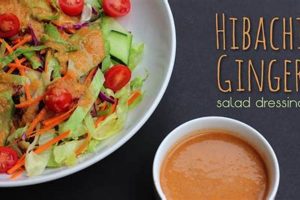A creamy, tangy emulsion typically made with yogurt, olive oil, lemon juice, garlic, Worcestershire sauce, and seasonings serves as a healthier alternative to traditional Caesar dressing. This variation often incorporates anchovy paste or fillets for the characteristic umami flavor, though vegetarian versions omit this ingredient. A classic preparation might involve blending the yogurt, oil, and seasonings until smooth, then adding Parmesan cheese for extra richness. This style of dressing offers a lighter, more refreshing take on the classic while providing a good source of protein and probiotics from the yogurt.
Using yogurt offers several advantages. It reduces the overall fat and calorie content compared to versions using mayonnaise or raw egg yolks, aligning with contemporary health-conscious preferences. The probiotics in yogurt contribute to gut health, and the tangy flavor complements the other ingredients without overpowering them. This adaptation allows individuals with dietary restrictions related to eggs or raw ingredients to enjoy a Caesar salad. While the original Caesar dressing emerged in the early 20th century, the use of yogurt is a more recent innovation reflecting evolving culinary trends and nutritional awareness.
The following sections will explore various aspects of this healthier dressing, including specific recipes, nutritional information, variations for different dietary needs, and tips for achieving the perfect texture and flavor balance.
Tips for a Perfect Yogurt-Based Caesar Dressing
Achieving optimal flavor and texture with a yogurt-based Caesar dressing requires attention to detail. The following tips offer guidance for creating a delicious and healthy dressing.
Tip 1: Choose the Right Yogurt: Greek yogurt provides the best consistency due to its thickness. Plain, unflavored varieties allow for complete control over the final flavor profile. Avoid flavored yogurts, as they can clash with the other ingredients.
Tip 2: Emulsify Thoroughly: Proper emulsification creates a smooth, creamy texture. Start by whisking together the yogurt, lemon juice, and seasonings. Slowly drizzle in the olive oil while whisking constantly until the mixture thickens and emulsifies.
Tip 3: Balance Tanginess and Saltiness: Taste and adjust the lemon juice and seasonings as needed. The ideal balance offers a pleasant tanginess from the lemon juice balanced by the saltiness of the anchovies (if used) and other seasonings.
Tip 4: Incorporate Umami Carefully: If using anchovy paste or fillets, add them sparingly. Too much can overpower the other flavors. Vegetarian alternatives include a splash of Worcestershire sauce or a pinch of nutritional yeast.
Tip 5: Enhance with Parmesan: Freshly grated Parmesan cheese adds depth and richness. Add it towards the end of the preparation, after the dressing has emulsified. Avoid pre-grated Parmesan, as it often contains cellulose which can affect texture.
Tip 6: Adjust Consistency: If the dressing is too thick, thin it with a tablespoon or two of water or additional lemon juice. If too thin, add more Greek yogurt until the desired consistency is reached.
Tip 7: Refrigerate for Optimal Flavor: Allow the dressing to chill in the refrigerator for at least 30 minutes before serving. This allows the flavors to meld and intensifies the overall taste.
By following these tips, one can consistently create a healthy and flavorful yogurt-based Caesar dressing that rivals traditional versions. The resulting dressing offers a lighter, tangier alternative, perfect for health-conscious individuals without sacrificing flavor.
The concluding section will summarize the key benefits and offer final recommendations for incorporating this dressing into a variety of culinary creations.
1. Yogurt (Greek)
Greek yogurt stands as a pivotal ingredient in contemporary Caesar salad dressing recipes, offering a healthier and equally flavorful alternative to traditional mayonnaise or raw egg-based emulsions. Its inclusion not only alters the nutritional profile but also impacts the texture and overall taste experience. Understanding the specific characteristics of Greek yogurt clarifies its role in creating a successful Caesar dressing.
- Texture and Consistency
Greek yogurt’s thick, creamy consistency provides body to the dressing, enabling it to coat lettuce leaves effectively. This texture arises from the straining process that removes excess whey, resulting in a denser product compared to standard yogurt. The viscosity contributes to the dressing’s ability to cling to the salad ingredients without becoming watery.
- Tanginess and Flavor Profile
The characteristic tang of Greek yogurt complements the other Caesar dressing components, balancing the richness of the olive oil and the sharpness of the lemon juice. This subtle tartness enhances the overall flavor complexity without overpowering the other elements. It offers a refreshing counterpoint to the savory notes of the anchovies (if used) and Parmesan cheese.
- Nutritional Benefits
Greek yogurt’s high protein content contributes to a more satiating salad experience. It also offers a source of probiotics, beneficial bacteria that support gut health. Compared to traditional Caesar dressings, the use of Greek yogurt generally lowers the overall fat and calorie content, aligning with health-conscious dietary preferences.
- Versatility and Adaptability
Greek yogurt’s neutral flavor profile makes it a versatile base for various flavor combinations. It readily accepts the addition of ingredients like garlic, anchovy paste, and spices, allowing for customization of the dressing’s taste. This adaptability extends to accommodating dietary restrictions, as it provides a suitable substitute for those avoiding eggs or raw ingredients.
The selection of Greek yogurt as the foundational component significantly influences the final outcome of a Caesar salad dressing recipe. Its unique properties regarding texture, flavor, nutrition, and adaptability collectively contribute to a healthier, flavorful, and versatile dressing suitable for a wide range of palates and dietary needs. It represents a key adaptation in classic culinary practices, reflecting contemporary trends towards health and wellness.
2. Olive Oil
Olive oil plays a crucial role in yogurt-based Caesar salad dressings, contributing significantly to both flavor and texture. Its presence within the emulsion affects the dressing’s mouthfeel, its interaction with other ingredients, and its overall sensory experience. Understanding the impact of olive oil selection and incorporation is essential for crafting a well-balanced and palatable dressing.
The type of olive oil influences the dressing’s final flavor profile. Extra virgin olive oil, with its robust flavor and lower acidity, imparts a peppery, fruity note that complements the tanginess of the yogurt and the savory elements of the dressing. Using a milder olive oil allows the other flavors to shine, while a more intense oil can add a distinct character. The quality of the olive oil directly impacts the overall quality of the dressing. High-quality extra virgin olive oil offers a superior sensory experience compared to refined or lower-grade oils.
Beyond flavor, olive oil contributes to the dressing’s emulsification process. As a fat, it binds with the yogurt and lemon juice, creating a stable emulsion that prevents separation. The quantity of olive oil used affects the dressing’s thickness and consistency. Too little oil results in a thin, watery dressing, while too much can make it overly rich and heavy. Achieving the correct balance is essential for a dressing that coats the salad ingredients evenly without being greasy.
Furthermore, olive oil acts as a carrier for flavor compounds present in other ingredients, such as garlic and anchovies. Its ability to dissolve and distribute these flavors enhances the overall taste complexity of the dressing. The oil also contributes to the dressing’s visual appeal, providing a glossy sheen that makes the salad more appetizing.
In summary, the careful selection and incorporation of olive oil are vital for a successful yogurt-based Caesar salad dressing. Its impact on flavor, texture, emulsification, and aroma contributes significantly to the overall culinary experience. The interplay between the olive oil and other ingredients like yogurt, lemon juice, and seasonings determines the final balance and complexity of the dressing.
3. Lemon juice (fresh)
Fresh lemon juice provides essential acidity in yogurt-based Caesar salad dressings, balancing the richness of the yogurt and olive oil while contributing brightness to the overall flavor profile. Its chemical properties facilitate emulsification and enhance the preservation of the dressing. The citric acid in lemon juice interacts with the other ingredients, creating a harmonious balance that prevents the dressing from becoming overly rich or bland. This acidity also helps to “cook” the raw garlic, mitigating its harshness and integrating its flavor more smoothly into the dressing. Without sufficient acidity, the dressing may taste flat and lack the characteristic tang of a Caesar dressing. For example, if a recipe calls for a milder olive oil, a higher proportion of lemon juice might be required to maintain the balance.
Beyond its flavor contribution, fresh lemon juice plays a functional role in the emulsification process. The acidity helps to stabilize the mixture of yogurt and olive oil, preventing separation and ensuring a smooth, creamy texture. This stabilization is crucial for the dressings ability to cling to the salad ingredients. Furthermore, the antimicrobial properties of lemon juice contribute to the dressings shelf life, inhibiting bacterial growth and maintaining its quality for a longer period. This natural preservation effect aligns with contemporary preferences for minimizing the use of artificial preservatives. In practical applications, the quantity of lemon juice may be adjusted based on individual preferences and the specific yogurt used. A thicker Greek yogurt might require slightly more lemon juice to achieve the desired tanginess compared to a thinner variety.
In summary, fresh lemon juice serves as a vital component in yogurt-based Caesar salad dressings, contributing not only to its characteristic tangy flavor but also to its stability and preservation. Its chemical interaction with other ingredients ensures a balanced and harmonious flavor profile while enhancing the dressings functionality. Understanding the role of lemon juice allows for informed adjustments to recipes, ensuring optimal flavor and texture while maximizing shelf life.
4. Garlic (minced)
Minced garlic forms an integral part of a yogurt-based Caesar salad dressing, contributing a pungent and savory depth that complements the other ingredients. Its sharp, aromatic flavor profile undergoes transformation when combined with the acidic lemon juice and creamy yogurt. The acid in the lemon juice mellows the raw garlic’s intensity, preventing it from overpowering the dressing while retaining its characteristic pungency. This interaction allows the garlic’s complex flavor notes to meld seamlessly with the other components, creating a more balanced and nuanced taste. For instance, if a milder garlic flavor is desired, allowing the minced garlic to sit in the lemon juice for a few minutes before incorporating the other ingredients can further temper its intensity. Conversely, for a more pronounced garlic presence, freshly minced garlic can be added directly to the yogurt mixture.
The choice of fresh garlic over other forms, such as garlic powder or pre-minced garlic, impacts the final dressing’s quality. Fresh garlic offers a more vibrant and complex flavor profile compared to processed alternatives. Mincing the garlic rather than using larger pieces ensures even distribution of flavor throughout the dressing and avoids overpowering bites of raw garlic. The size of the mince can be adjusted to influence the intensity a finer mince yields a more pronounced flavor, while a coarser chop offers a milder taste. Incorporating minced garlic into the dressing during the emulsification process allows the flavors to meld effectively with the yogurt and olive oil. If the garlic is added too early, it may not distribute evenly, resulting in pockets of intense flavor. Conversely, adding it too late might limit its ability to fully integrate with the other components.
Understanding the role of minced garlic, its interaction with other ingredients, and the importance of using fresh garlic are essential factors in creating a well-balanced and flavorful yogurt-based Caesar salad dressing. Attention to these details, including mincing technique and timing of incorporation, elevates the dressing beyond a simple mixture of ingredients to a carefully crafted culinary creation. This careful consideration of the garlic’s impact ultimately contributes to the overall dining experience, ensuring a harmonious blend of flavors and textures.
5. Seasoning (salt, pepper)
Seasoning, primarily with salt and pepper, plays a crucial role in yogurt-based Caesar salad dressings, influencing the overall flavor profile and enhancing the perception of other ingredients. Salt, in particular, acts as a flavor enhancer, amplifying the inherent tastes of the yogurt, olive oil, garlic, and any other additions like anchovies or Worcestershire sauce. It modulates the perceived acidity of the lemon juice, creating a balanced flavor profile. Insufficient salt can result in a bland dressing, while excessive salt can overpower the other flavors. Pepper adds a subtle layer of complexity, contributing a mild spiciness and enhancing the aromatic profile of the dressing. The balance between salt and pepper is critical; the goal is not to taste salt or pepper distinctly but rather to experience their synergistic effect on the overall flavor composition. A classic example is the interplay of salt with anchovies; the salt intensifies the anchovy’s umami notes, creating a savory depth that characterizes traditional Caesar dressings. Similarly, salt enhances the inherent tanginess of the yogurt, preventing the dressing from tasting overly acidic.
The type of salt used can subtly influence the final taste. Sea salt, with its coarser texture and mineral complexity, can add a nuanced dimension to the dressing. Freshly ground black pepper offers a more pronounced aroma and flavor compared to pre-ground pepper, which can lose its potency over time. The timing of seasoning also matters. Adding salt gradually during the preparation process allows for continuous tasting and adjustment, ensuring optimal balance. Furthermore, the interaction of salt with the other ingredients can affect the dressing’s texture. Salt can influence the yogurt’s consistency, potentially thickening or thinning it depending on the type of yogurt used. Understanding these nuances empowers one to achieve precise control over the final product, tailoring the seasoning to individual preferences and specific ingredient combinations. For instance, a dressing using a milder olive oil might benefit from a slightly higher amount of pepper to enhance its overall flavor profile.
In conclusion, the judicious use of salt and pepper is fundamental to a successful yogurt-based Caesar salad dressing. Their role extends beyond simple seasoning; they actively shape the interplay of flavors, enhance the perception of other ingredients, and even influence the texture. A deep understanding of these effects allows for a more nuanced approach to seasoning, transforming the dressing from a simple mixture into a balanced and flavorful culinary creation. The seemingly simple act of seasoning becomes a crucial step in achieving the perfect balance of tanginess, savoriness, and richness that defines a truly exceptional Caesar dressing.
6. Anchovy paste (optional)
Anchovy paste represents a key ingredient in traditional Caesar salad dressings, contributing a distinctive umami richness and salty depth. While its inclusion in yogurt-based versions remains optional, understanding its role in flavor development provides valuable context for creating a well-rounded dressing. The intense savoriness of anchovy paste complements the other ingredients, adding complexity and balancing the tanginess of the yogurt and lemon juice. This exploration examines the various facets of anchovy paste’s contribution to a yogurt-based Caesar dressing, considering both its flavor impact and its optional nature.
- Umami and Savory Depth
Anchovy paste contributes a significant umami punch, often described as a savory, meaty, or brothy flavor. This umami richness deepens the overall taste profile of the dressing, adding complexity beyond the basic tanginess and richness. The glutamates present in anchovies interact with other ingredients, enhancing their inherent flavors and creating a synergistic effect. This interplay of umami with the acidity and creaminess of the dressing forms a balanced and moreish flavor profile. In a yogurt-based version, the umami from anchovy paste can be particularly valuable in offsetting the yogurt’s natural tang.
- Saltiness and Flavor Balance
Anchovy paste’s inherent saltiness contributes to the overall seasoning of the dressing, reducing the need for added salt. This saltiness complements the other flavors, balancing the acidity of the lemon juice and the richness of the olive oil. The interplay of saltiness, acidity, and richness is crucial for creating a harmonious flavor profile. However, due to its intensity, anchovy paste must be used judiciously to avoid over-salting the dressing. In the context of a yogurt-based Caesar dressing, the saltiness of the anchovy paste can help to balance the sometimes perceived blandness of plain yogurt.
- Optional Inclusion and Flavor Flexibility
The optional nature of anchovy paste in yogurt-based Caesar dressings allows for flexibility in catering to different palates and dietary preferences. Those averse to the strong flavor of anchovies can omit the paste entirely without significantly compromising the dressing’s overall balance. This adaptability makes yogurt-based Caesar dressings more inclusive, accommodating individuals with dietary restrictions or aversions to seafood. The omission of anchovy paste might necessitate minor adjustments to the seasoning, possibly requiring a touch more salt or the addition of other umami-rich ingredients like Worcestershire sauce or nutritional yeast.
- Alternatives for Umami and Depth
For those omitting anchovy paste, alternative ingredients can provide similar umami notes and savory depth. Worcestershire sauce, often containing anchovies itself, offers a less intense but still recognizable umami contribution. Nutritional yeast, a deactivated yeast with a cheesy, nutty flavor, also provides a degree of umami and can add depth to the dressing. Other options include capers, miso paste, or even a small amount of finely grated Parmesan cheese. These alternatives allow individuals to customize the dressing to their liking while still achieving a complex and flavorful result. In a yogurt-based Caesar dressing, these alternatives can play a crucial role in achieving the desired depth of flavor without relying on the potentially polarizing taste of anchovies.
The inclusion or omission of anchovy paste significantly impacts the final flavor profile of a yogurt-based Caesar salad dressing. Understanding its role in contributing umami, saltiness, and depth allows for informed decision-making when adapting recipes. While traditional Caesar dressings rely heavily on anchovies, the flexibility of yogurt-based versions offers a wider range of flavor possibilities, catering to both anchovy enthusiasts and those seeking alternative flavor profiles. By carefully considering the role of anchovy paste and its potential substitutes, one can create a customized dressing that perfectly balances tanginess, richness, and savory depth.
7. Parmesan Cheese (Grated)
Grated Parmesan cheese contributes significantly to the overall flavor profile and texture of yogurt-based Caesar salad dressings. Its integration into the emulsion extends beyond mere seasoning, influencing the dressing’s complexity, richness, and ability to coat the salad ingredients. This exploration examines the multifaceted role of grated Parmesan cheese in a yogurt-based Caesar dressing.
- Flavor Enhancement and Complexity
Parmesan cheese imparts a sharp, salty, and umami-rich flavor to the dressing, complementing the tanginess of the yogurt and the richness of the olive oil. Its complex flavor profile, derived from the aging process, adds depth and character to the dressing, preventing it from tasting one-dimensional. The hard texture of Parmesan, even when grated, introduces subtle textural variations within the creamy emulsion, enhancing the sensory experience. The saltiness of Parmesan contributes to the overall seasoning of the dressing, often reducing the need for additional salt. This natural saltiness, combined with its inherent umami, plays a critical role in balancing the other flavors. For example, the sharp, salty notes of Parmesan can offset the sweetness of certain lettuces commonly used in Caesar salads, such as romaine.
- Texture and Binding
Finely grated Parmesan cheese acts as a mild binding agent in the dressing, contributing to its ability to cling to the salad leaves. The small particles of cheese create friction within the emulsion, increasing its viscosity and preventing it from becoming watery or separating. This textural influence enhances the overall mouthfeel and ensures even distribution of flavor across the salad. The fineness of the grating affects the cheese’s ability to incorporate smoothly into the dressing; coarsely grated Parmesan may clump or settle, while finely grated Parmesan disperses evenly, contributing to a smoother, more homogenous texture.
- Nutritional Contribution
Parmesan cheese, a good source of calcium and protein, adds nutritional value to the dressing. While present in relatively small quantities, its inclusion contributes to a more balanced nutritional profile for the salad as a whole. This nutritional aspect aligns with the health-conscious nature of yogurt-based Caesar dressings. Furthermore, the calcium in Parmesan can interact with other components of the dressing, influencing its texture and stability.
- Visual Appeal and Presentation
The addition of grated Parmesan cheese enhances the visual appeal of the dressing, adding specks of white against the creamy backdrop. This visual element contributes to the overall presentation of the salad, making it more appetizing. Freshly grated Parmesan, with its irregular shapes and varied sizes, offers a more visually appealing texture compared to pre-grated varieties, which often appear uniform and processed. This visual enhancement, while subtle, contributes to the overall dining experience, adding an element of rustic charm to the salad’s presentation.
In conclusion, the incorporation of grated Parmesan cheese elevates yogurt-based Caesar salad dressings beyond simple emulsions of yogurt, oil, and seasonings. Its multifaceted contribution encompasses flavor enhancement, textural improvement, nutritional enrichment, and visual appeal. Understanding the interplay between Parmesan and the other ingredients enables a more nuanced approach to crafting a well-balanced and flavorful dressing. The careful consideration of grating size, quality of cheese, and timing of incorporation allows for precise control over the final product, ensuring a harmonious blend of taste, texture, and presentation. This attention to detail transforms the inclusion of Parmesan from a mere ingredient addition to a deliberate culinary choice that elevates the overall dining experience.
Frequently Asked Questions
This section addresses common inquiries regarding Caesar salad dressings prepared with yogurt, offering concise and informative responses.
Question 1: How does yogurt-based Caesar dressing compare nutritionally to traditional versions?
Yogurt-based versions typically contain less fat and fewer calories due to the substitution of yogurt for mayonnaise or raw egg yolks. They also offer additional protein and probiotics.
Question 2: Can individuals with egg allergies safely consume this dressing?
Yes, the absence of raw eggs makes this a suitable alternative for individuals with egg allergies or sensitivities. Always confirm all ingredients to ensure they align with specific dietary restrictions.
Question 3: What type of yogurt is recommended for optimal texture and flavor?
Thick, plain Greek yogurt is generally preferred for its creamy consistency and neutral flavor profile, allowing other ingredients to shine.
Question 4: How can the dressing’s thickness be adjusted?
If too thick, a small amount of water or additional lemon juice can be added. If too thin, incorporate more Greek yogurt to achieve the desired consistency.
Question 5: Does this dressing require refrigeration?
Refrigeration is essential for maintaining freshness and preventing bacterial growth. It is recommended to store the dressing in an airtight container in the refrigerator for up to one week.
Question 6: What can be substituted for anchovy paste in vegetarian preparations?
Worcestershire sauce, nutritional yeast, or finely grated Parmesan cheese can provide umami and savory depth in place of anchovy paste.
Careful consideration of these frequently asked questions facilitates a comprehensive understanding of yogurt-based Caesar dressings, enabling informed choices regarding preparation and consumption.
The subsequent section will offer a selection of curated recipes for preparing this versatile and healthful dressing.
Caesar Salad Dressing Recipe with Yogurt
Exploration of Caesar salad dressing recipes incorporating yogurt reveals a versatile and healthful alternative to traditional preparations. Analysis of core ingredientsGreek yogurt, olive oil, lemon juice, garlic, seasonings, optional anchovy paste, and Parmesan cheesedemonstrates the complex interplay contributing to the dressing’s characteristic flavor profile. Emphasis on ingredient quality, proper emulsification techniques, and balanced seasoning underscores the potential for culinary refinement. The adaptability of yogurt-based dressings to accommodate dietary restrictions, particularly egg allergies, expands accessibility to this classic culinary creation. Nutritional advantages, including reduced fat and increased protein content compared to traditional mayonnaise-based versions, align with contemporary health-conscious preferences. Furthermore, the exploration of umami-rich alternatives to anchovy paste broadens the appeal and customizability of this dressing.
The evolution of Caesar salad dressing recipes to incorporate yogurt reflects broader culinary trends toward healthier and more adaptable cuisine. Continued experimentation with flavor profiles and ingredient combinations promises further innovation within this culinary space. Adoption of yogurt-based Caesar dressings presents an opportunity to enhance both nutritional intake and culinary experiences, suggesting a promising trajectory for future culinary adaptations.






